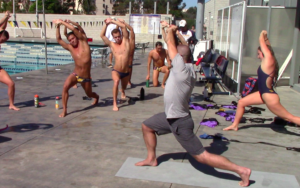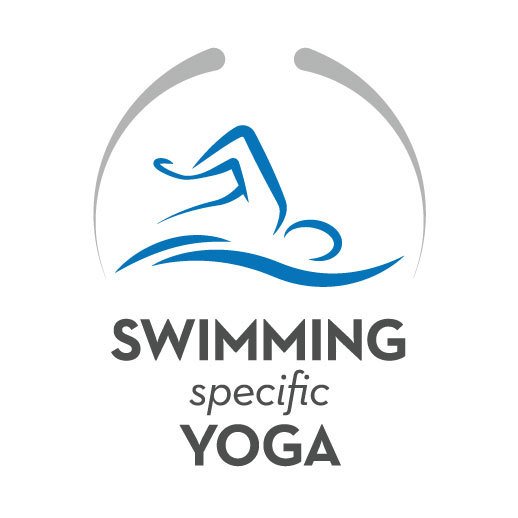Incorporating a swimming-specific yoga practice into your training can be an effective way to accomplish many of your dryland goals.
When incorporating any modality into your program there are many considerations:
- Goals for the specific modality
- Timing
- Time restraints
- Access to facilities and equipment
- Delivery of the program
What is Your Goal for Doing a Swimming-Specific Yoga Practice?
Some of the benefits of a swimming-specific yoga practice include:
- Increasing mobility
- Improving strength
- Optimizing recovery
- Developing body awareness
- Injury prevention
- Breathing efficiency
- Moving with ease
- Mental Skills
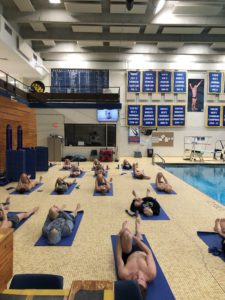
When implementing any type of training knowing what you want to achieve is essential. All of the goals above are worthwhile, but it is up to the athlete and/or coach to decide what will be the most effective element to focus on and when to focus on it.
It is important to ensure that there is a purposeful coordination of all your training. If your goal is to optimize recovery both the type of yoga and the timing of the practice needs to be appropriate to achieve that objective.
Yoga is a piece of a training puzzle. It is a practice with multiple benefits achieved in an integrated way. If you are limited in time, space and funds it can help you incorporate a well rounded dryland program.
Like any training it has its limitations. A yoga practice is not appropriate to build maximum strength or power. There are different types of dryland training that should be implemented if these are your goals.
How Does a Swimming-Specific Yoga Practice Fit Into Your Periodization?
“If you fail to plan, you are planning to fail.” – Benjamin Franklin
At its heart periodization is a fancy word for purposeful planning. There are many structures and models of periodization. Whatever system you use it is important to determine when to implement different aspects of a yoga practice so it will be an effective part of your training.
The work you do in the water is your first priority. How other modalities affect the way you move in the water and adapt to that training is the most important consideration. A yoga practice should enhance the training you do in the water, not take away from it.
After determining why you are practicing yoga, how you fit it into your overall training program in a systematic way is the next key step in making it effective.
Macrocycle
A macrocycle is a longer period of time that most often ends with a peak competition. This is where you determine what training modalities will be used in the coming months and decide how big a piece of your training puzzle a swimming-specific yoga practice will be.
Mesocycle
A mesocycle is a training block with a specific emphasis. The question to ask yourself is; What element of a swimming-specific yoga practice will positively effect the process of achieving the overall goal of this phase?
If you are focusing on building strength having a yoga practice that targets mobility can be a beneficial way to balance your training. If you are heading into a competitive phase having yoga practices with the goal of optimizing recovery is ideal.
 Microcycle
Microcycle
A microcycle is the shortest of training cycles, most often lasting a week. The timing of a yoga session is determined by the goals of your workouts in the pool or open water and other strength and conditioning training. Yoga can be done before or after your in water training as well as on its own.
When doing a session before a practice focusing on things such as active mobility, activation, body awareness, breathing and mental skills is appropriate. After a practice concentration can be put on many different areas with the most common being recovery, mobility and breathing.
A session done on its own does not have restrictions as long as it fits systematically into your overall training plan.
How Much Time Should You Dedicate to a Swimming-Specific Yoga Practice?
Your answers to the questions above will determine how much time you need to dedicate to a yoga practice to achieve your goals.
An ideal duration is 45 minutes to an hour, but you do not need that much time to reap the benefits of a yoga practice. An effective session can be done in as little as 15 minutes.
Try doing a few poses and breathing practices before going to bed. This can often help you get to sleep with greater ease (the greatest recovery tool of them all). This is an example of how a short practice can have a big impact on your overall training.
If you are short on time, but believe that yoga will have a positive effect on your performance start with shorter sessions that are realistic and eventually you will find the time for more.
What Facilities Do You Need to Incorporate a Swimming-Specific Yoga Practice?
The ideal facility is very different than what is necessary. Just as a 50-meter pool is ideal you don’t need one to excel in the sport.
The ideal:
- Mats
- Props including straps, blocks and bolsters
- Forgiving flooring
- Quiet space
- Appropriate lighting
What is necessary:
- A place that is easy to breath
- A surface with traction
Implementing a swimming-specific yoga practice can be simple no matter what resources you have. Yoga mats, straps and blocks are now available at dollar stores. When it comes to the facility I have taught sessions to swimmers on noisy pool decks, soccer fields and busy gymnasiums.
Methods to Use to Incorporate a Swimming-Specific Yoga Practice
Online
Online programs are a cost effective way to access an expert in the field at any time anywhere.
In Person Teacher
There are many good yoga teachers, but when bringing someone in you should ensure:
- They understand how yoga fits into your overall training plan
- The unique needs swimmers have
- You resonate with personality of the teacher
Using Different Components
Implementing different aspects of a yoga practice into your dryland training can be quite simple. Many sequences involve very common dryland activities performed with greater awareness and connection to the breath.
Classes Outside of Structured Training
Just as there are many great yoga teachers there are a lot of incredible classes. When doing a separate practice ensure that what you are doing fits into the periodization of your program.
The Bottom Line
There is no one size fits all training plan. For a swimming-specific yoga practice to be as effective as possible, you as a coach or athlete needs to determine how to incorporate it so it complements and enhances your program.
The goal of this article is to arm you with information so that you can implement a swimming-specific yoga practice into your training effectively to achieve a peak performance.
…
This Yoga for Swimmers article is brought to you by Swimming-Specific Yoga the world’s top resource for online yoga classes and content designed for swimmers and multi-sport athletes.
To learn more about how yoga can help your swimming performance sign up for our newsletter and join the Swimming-Specific Yoga Community
“Jeff is very knowledgeable in the practice of yoga and how it connects to the sport of swimming, and has helped me so much over the years.
By combining the art of yoga with the specificities of the sport of swimming, I have been able to improve my swimming specific strength and flexibility, which has allowed me to progress myself in the pool.
The way that he is able to allow me to disconnect myself from all the distractions around me, while finding a deeper connection with my body and mind, has made his class an amazing experience for me as an athlete.”
Raben Dommann
Canadian National Team (5 km Open Water)
Visit our website swimminspecificyoga.com to take a 7 day free trial of the Swimming-Specific Yoga Online Studio membership.
With your membership you gain access to over 100 classes ranging from 15-60 minutes that have been created for the specific needs of swimmers.
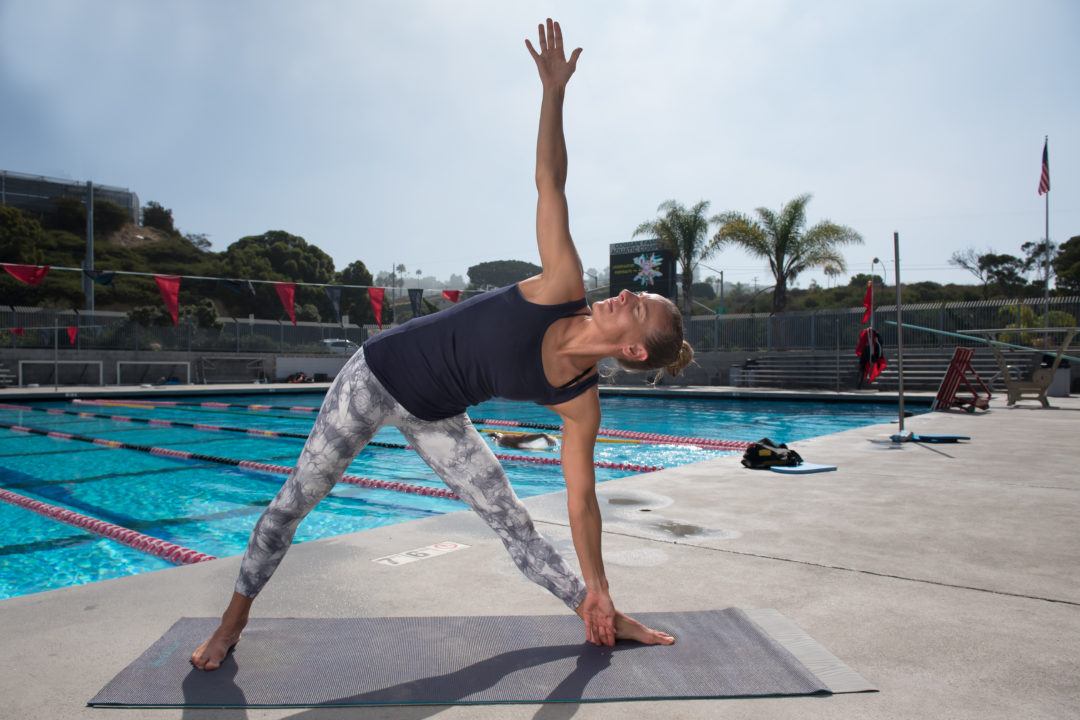
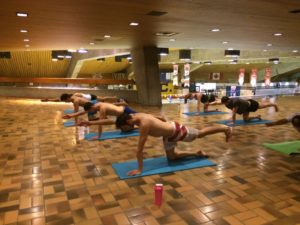 Microcycle
Microcycle